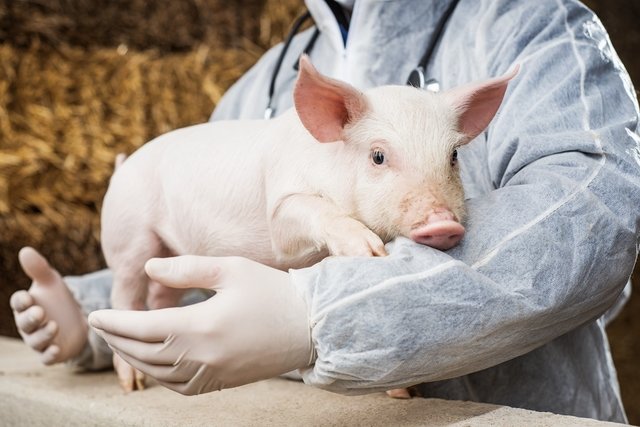Swine flu is a respiratory disease caused by the Influenza A virus, also known as H1N1 flu, which can be transmitted through direct contact with infected pigs or through droplets of saliva released into the air when a person with the flu coughs or sneezes.
The symptoms of swine flu are similar to those of the common flu, such as fever, general malaise and headache, and usually appear 3 to 5 days after contact with the virus.
The treatment of swine flu depends on the severity of the symptoms, and the doctor may recommend rest, increased fluid intake or the use of anti-inflammatory or antiviral medications, and in more serious cases hospitalization.

Swine flu symptoms
The main symptoms of swine flu are:
- High fever, above 38ºC;
- Tiredness;
- Headache;
- Persistent cough;
- Loss of appetite;
- Sore throat;
- Sneezing, runny or stuffy nose;
- Body pain and general discomfort;
Symptoms of bird flu usually appear 3 to 5 days after contact with the H1N1 virus, and in some cases symptoms such as diarrhea, nausea and vomiting may also appear.
In addition, the person can also develop serious respiratory complications a few days after the onset of symptoms, which can result in respiratory failure.
Therefore, it is important to consult your general practitioner or go to the hospital whenever symptoms of swine flu appear, so that the most appropriate treatment can be diagnosed and initiated.
How to confirm the diagnosis
The diagnosis of swine flu is made by the general practitioner through the assessment of symptoms, in addition to blood tests and the RT-PCR test, in which a sample of secretions from the nose or throat is collected to check the presence of the virus. Find out how the RT-PCR exam is performed.
This test also helps to rule out other conditions with similar symptoms, such as adenovirus, cytomegalovirus or dengue infections, or severe acute respiratory syndrome (SARS), for example.
If you have symptoms of swine flu and want to see a general practitioner, schedule an appointment in the nearest region:
Taking care of your health has never been easier!
How transmission happens
Swine flu is transmitted through droplets of saliva and respiratory secretions that remain suspended in the air when the infected person coughs, sneezes or speaks.
Furthermore, this virus is capable of remaining on surfaces for up to 8 hours and, therefore, it is possible that the disease can also be transmitted through contact with contaminated surfaces.
Swine flu can also be transmitted through direct contact with infected pigs, however, transmission does not occur when meat from these pigs is consumed, because the virus is inactivated and eliminated when exposed to high temperatures.
How the treatment is carried out
The treatment of swine flu must be carried out with the guidance of a general practitioner or infectious disease specialist, and isolation is normally recommended to avoid transmitting the virus to another person, in addition to rest, fluid intake and a light, easily digestible diet.
In addition, the doctor may recommend the use of antiviral medications, such as zanamivir or oseltamivir, to be started within 48 hours after the onset of symptoms, as they reduce the rate at which the virus multiplies and reduce the severity of symptoms, preventing complications.
In more serious cases, mechanical ventilation may also be necessary to avoid respiratory failure and, in these cases, the use of antibiotics may also be indicated to prevent secondary bacterial infections.
Possible complications
The main complications of swine flu are dehydration, viral or bacterial pneumonia, hemorrhagic bronchitis, acute respiratory distress syndrome or respiratory arrest.
These complications are more common in pregnant women or people who have other diseases such as COPD, bronchial asthma, diabetes, autoimmune or heart diseases or who are being treated for cancer.
How to prevent
It is important that measures are adopted to help prevent infection and transmission of swine flu, such as:
- Avoid sharing objects for personal use,
- Avoid staying in a closed environment for a long time or with little air circulation
- Avoid contact with people suspected of having swine flu,
- Avoid touching surfaces and touching your eyes, mouth or nose;
- Always cover your nose and mouth when coughing or sneezing, using a disposable tissue or clothing;
- Isolate yourself for 5 days, as this will prevent the transmission of the virus to other people.
In addition, you should wash your hands regularly, using water and neutral soap, for at least 20 seconds before rinsing, in order to prevent swine flu and prevent the transmission of the disease.

Sign up for our newsletter and stay up to date with exclusive news
that can transform your routine!
Warning: Undefined array key "title" in /home/storelat/public_html/wp-content/plugins/link-whisper-premium/templates/frontend/related-posts.php on line 12
Warning: Undefined array key "title_tag" in /home/storelat/public_html/wp-content/plugins/link-whisper-premium/templates/frontend/related-posts.php on line 13




